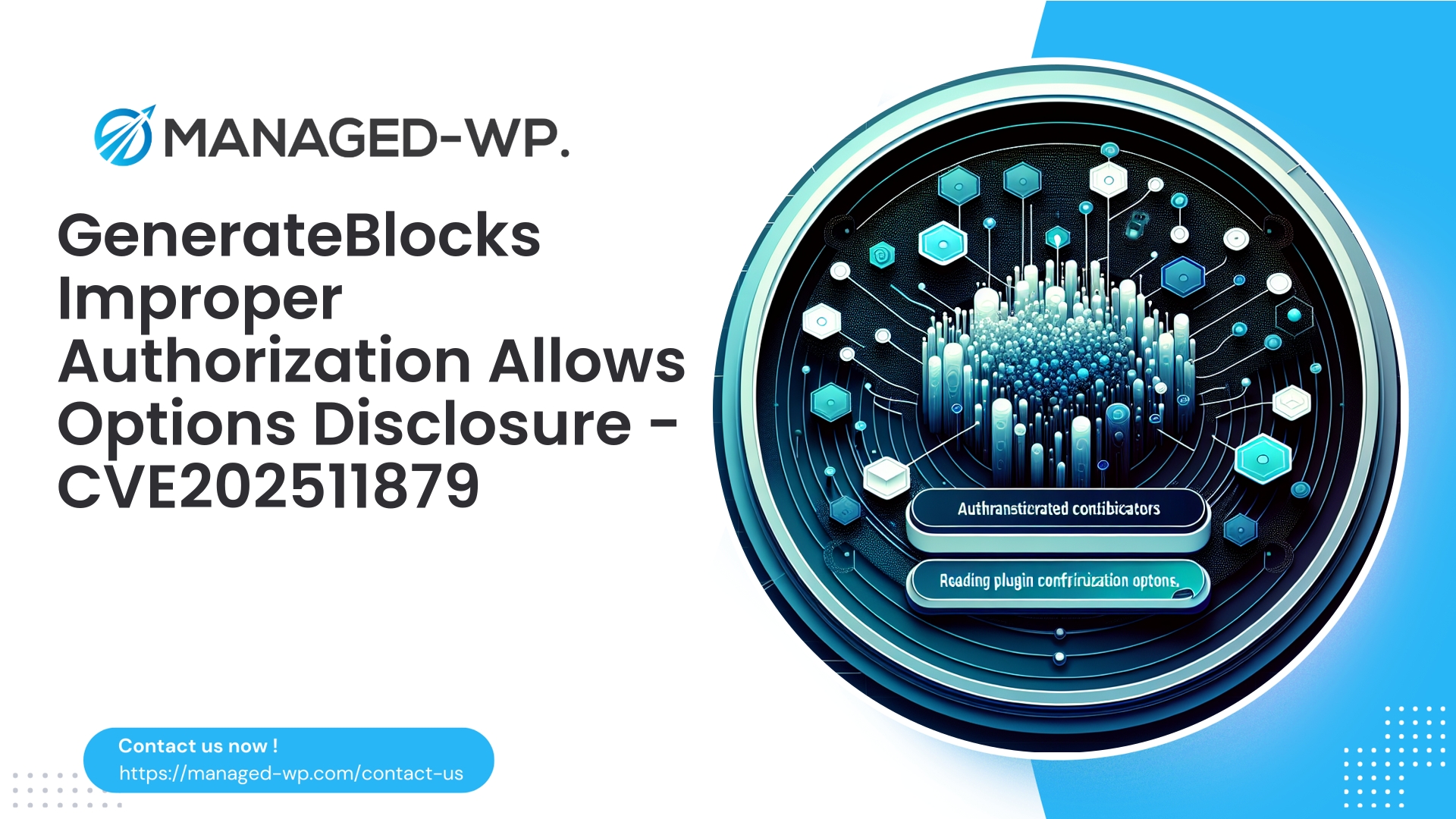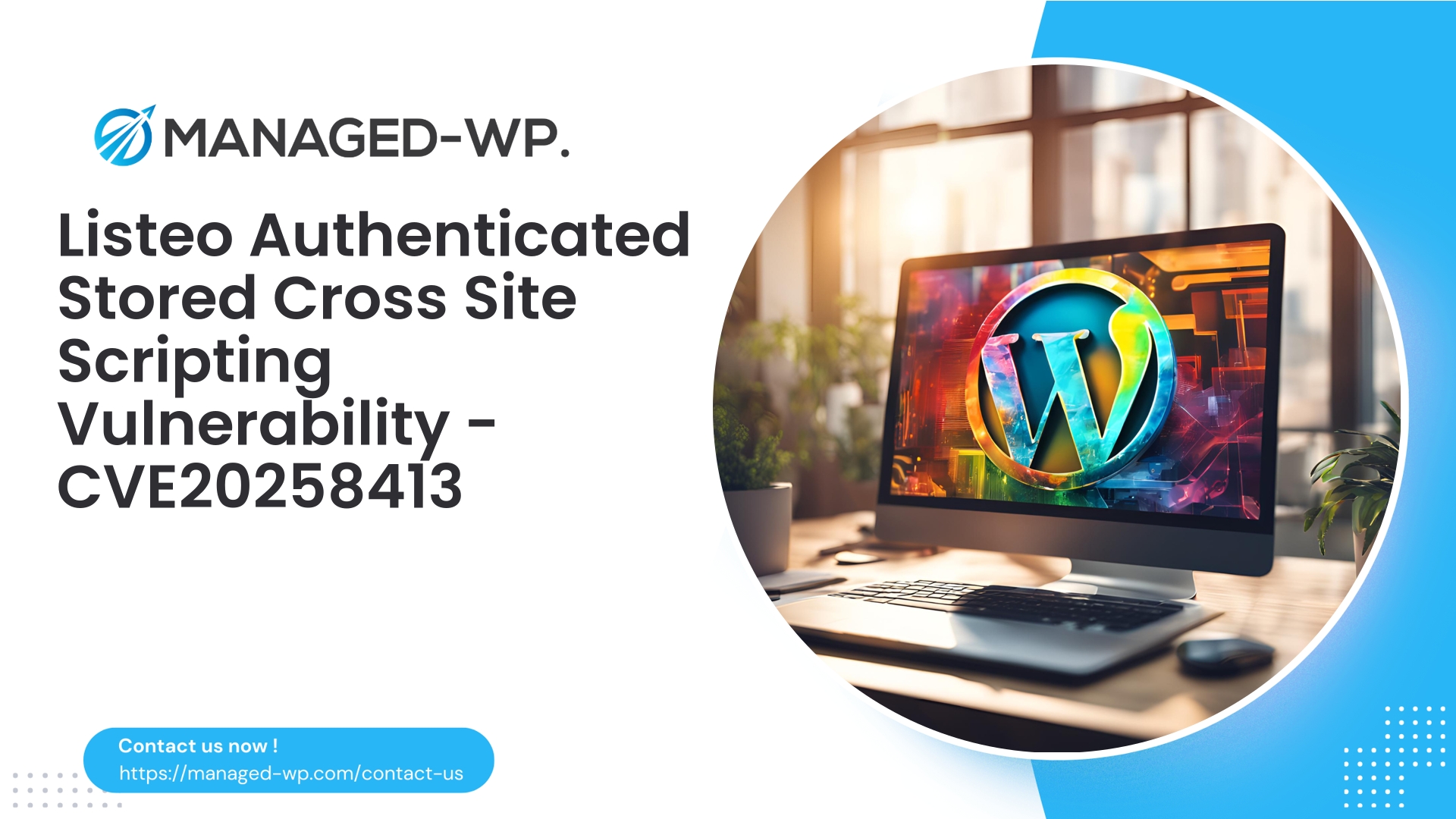| 插件名称 | 生成块 |
|---|---|
| 漏洞类型 | 访问控制失效 |
| CVE编号 | CVE-2025-11879 |
| 紧急 | 低的 |
| CVE 发布日期 | 2025-10-25 |
| 源网址 | CVE-2025-11879 |
GenerateBlocks <= 2.1.1 — 授权不当允许已认证的贡献者访问任意站点选项 (CVE-2025-11879)
日期: 2025年10月25日
作者: 托管式 WordPress 安全专家 — 美国 WordPress 安全专家
执行摘要: GenerateBlocks 2.1.1 及更早版本中存在一个严重的权限漏洞,该漏洞允许任何拥有“贡献者”或更高角色的已认证用户读取任意站点配置选项。此漏洞源于插件端点中授权检查不足,导致存储在 WordPress 选项表中的敏感数据暴露。该漏洞编号为 CVE-2025-11879,CVSS 评分为 6.5,已在 GenerateBlocks 2.1.2 版本中修复。
这份详细的简报涵盖了漏洞的性质、受影响的用户、实际攻击场景、检测策略、包括虚拟补丁在内的即时缓解措施以及长期加固建议。借助 Managed-WP 的安全洞察,我们还解释了高级托管防火墙解决方案如何在插件更新期间强制执行分层防御机制来降低这些风险。
目录
- 事件概述
- 漏洞技术分析
- 实际影响和攻击途径
- 受影响的环境
- 检测与取证
- 立即采取的应对措施
- 虚拟补丁和防火墙策略
- 建议的长期安全措施
- Managed-WP 如何保护您的 WordPress 网站
- 免费安保计划优惠
- 常见问题
- 摘要和行动清单
事件概述
GenerateBlocks 发布了一项安全更新,以修复一个授权绕过漏洞。该漏洞导致一个端点在未验证管理员权限的情况下暴露了插件选项。默认情况下,贡献者都是已认证用户,他们可以利用此漏洞访问敏感的站点选项,包括 API 密钥和配置密钥。 wp_options 表格。确保您的网站运行 GenerateBlocks 2.1.2 或更高版本对于消除这种风险至关重要。
漏洞技术分析
该漏洞本质上是一个授权缺陷,允许具有贡献者访问权限的已认证用户调用返回敏感选项数据的 REST/AJAX 端点,而无需验证其是否具备相应的权限。 管理选项该终端未能限制访问,从而暴露了可能敏感的内部设置。
关键技术要点:
- 所需权限:已认证贡献者或更高级别。
- 泄露的数据:插件控制/读取的任意选项值,包括密钥和配置标志。
wp_options. - 攻击途径:伪造经过身份验证的 HTTP 请求,目标是插件的管理 AJAX 或 REST API 端点。
- 补救措施:正确实施权限检查,例如:
current_user_can('manage_options')对请求的选项键进行清理。
我们不发布漏洞利用代码,但这一缺陷严重凸显了对具有中等权限的已认证用户角色缺乏足够访问控制的风险。
实际影响和攻击途径
虽然被归类为信息泄露漏洞,但其影响可能非常深远:
- API密钥和凭证的公开使得在集成系统内进行横向移动成为可能。
- 泄露的配置信息使攻击者能够策划定向攻击或提升权限。
- 选项可能包含盐值、功能开关或令牌等秘密信息,这些信息会破坏其他安全控制。
- 允许贡献者角色帐户的社区或多作者网站尤其容易受到攻击,因为攻击者可以注册或入侵此类帐户来利用此漏洞。
攻击过程示例:
- 攻击者获取或注册了一个贡献者帐户。
- 调用存在漏洞的插件端点来枚举选项值。
- 检索选项表中配置的敏感令牌或密钥。
- 利用泄露的机密信息来提升访问权限或入侵其他系统。
该漏洞与 OWASP 的“访问控制失效”类别非常吻合,因此需要紧急关注,尤其是在多用户网站上。
受影响的环境
- WordPress 网站运行的 GenerateBlocks 版本最高为 2.1.1。
- 已认证用户被分配了“贡献者”或更高角色的网站。
- 在 WordPress 选项表中存储敏感数据或第三方 API 令牌的网站。
请及时检查您的插件版本,如有需要请进行升级。
检测与取证
- 确认插件版本
可以使用 WP-Admin 或 WP-CLI:- WP-Admin:插件 → GenerateBlocks
- WP-CLI:
wp plugin status generateblocks --field=version
- 分析服务器日志
查找来自贡献者帐户或可疑 IP 地址的异常 admin-ajax.php 或 REST API 请求。查找带有选项枚举参数的请求。- 关键词:“generateblocks”在请求URI中,大型JSON响应。
- 数据库审计
查询最近或可疑的交易记录,查找异常的 API 密钥或令牌:SELECT option_name, option_value FROM wp_options WHERE option_value LIKE '%KEY%' OR option_value LIKE '%token%' LIMIT 100;
- 用户账户审核
通过 WP-CLI 或管理界面识别未识别或可疑的贡献者帐户。 - 文件完整性和恶意软件扫描
虽然此漏洞不会直接修改文件,但泄露的机密信息可能导致后续攻击。为安全起见,请运行完整性检查和病毒扫描。
立即采取的应对措施
- 请将 GenerateBlocks 更新至 2.1.2 或更高版本
彻底的解决方法是通过管理界面或WP-CLI及时更新:wp 插件更新 generateblocks
- 如果无法立即更新,则采取临时控制措施。
- a) 限制贡献者角色:移除或限制不受信任的贡献者帐户,并在没有必要的情况下禁用公开注册。
- b) 实施防火墙规则(虚拟补丁)阻止或限制对向非管理员用户公开选项的插件端点的访问。
- c) 加强 REST API 和 AJAX:在可行的情况下,限制或禁用低权限用户的 REST 端点。
- d) 轮换敏感秘密如果怀疑存在泄露风险,请立即轮换 API 令牌或凭证。
- 持续监测
持续审计日志,以发现针对受影响端点的任何异常访问模式。
虚拟补丁和防火墙策略
对于无法立即更新的站点,通过 Web 应用程序防火墙 (WAF) 规则进行虚拟修补可提供关键的风险缓解。
顶级控件
- 阻止非管理员会话向 GenerateBlocks 插件端点发出请求。
- 检测指示选项枚举的请求参数,并拒绝贡献者使用这些参数。
- 对贡献者角色限制对 admin-ajax.php 和 REST API 的请求速率。
防火墙规则示例概念(请谨慎调整和测试)
SecRule REQUEST_URI "@rx /wp-json/generateblocks|/admin-ajax.php" "chain,deny,status:403,msg:'阻止了 GenerateBlocks 选项披露尝试'" SecRule ARGS_NAMES|ARGS "@rx option_name|option|key|keys|settings" "chain"
- 检查 cookie 或身份验证令牌,以区分管理员和非管理员。
- 尽可能对 REST 路由强制执行 CSRF 或 nonce 检查。
虚拟补丁的优势
- 在安排插件更新的同时,立即阻止攻击尝试。
- 缓解自动扫描和批量枚举攻击。
- 为测试和部署永久性修复方案争取了关键时间。
Managed-WP 的托管防火墙解决方案提供现成的虚拟补丁规则,可有效保护您的整个环境。
建议的长期安全措施
- 最小权限角色管理: 定期审核用户角色。谨慎分配权限,并考虑为贡献者创建自定义角色。
- 秘密管理: 避免将敏感钥匙存放在
wp_options不使用加密或限制访问。建议使用环境变量或专用密钥管理解决方案。 - 定期安全审查: 密切关注插件更新和安全公告。订阅 WordPress 安全邮件列表。
- REST API 安全加固: 禁用未使用的端点,并尽可能限制只有经过身份验证的管理员用户才能访问。
- 集中式日志和安全信息与事件管理 (SIEM): 汇总日志并配置警报,以检测与 admin-ajax 或 REST 调用相关的异常模式。
- 纵深防御: 结合定期更新、WAF 防护、恶意软件扫描和受控用户权限,实现全面的风险降低。
Managed-WP 如何保护您的 WordPress 网站
Managed-WP 采用分层式主动防御策略来保障 WordPress 安全,该策略不仅限于打补丁:
- 托管式 WAF 和虚拟补丁:在新漏洞出现的第一时间自动部署定制的防火墙规则。
- 角色感知流量过滤分析身份验证令牌和 cookie,以区分管理员会话与贡献者或公共请求,阻止可疑活动。
- 持续恶意软件和完整性扫描:检测注入的后门、文件篡改或因凭证泄露而导致的横向移动。
- 警报和指导:提供有关攻击尝试的实时通知,以及明确的后续风险补救措施。
- 精心策划的更新:协调多个站点上的插件和核心更新,并进行更新前后的验证。
- 安全加固援助:启用一键式轻松配置,例如 REST API 限制、强密码强制执行以及禁用不必要的服务(如 XML-RPC)。
这些防御措施结合起来,可以大幅缩短漏洞暴露窗口期,并在漏洞出现时限制潜在损害。
几分钟内保护您的网站安全——试用 Managed-WP 免费安全计划
我们的免费套餐可提供即时保护,方便您在计划全面更新和加固措施时使用。它包括:
- 具有虚拟补丁功能的托管 WAF
- 无限带宽用于过滤恶意网络请求
- 集成恶意软件扫描
- 针对OWASP十大威胁的缓解措施
立即使用 Managed-WP 免费计划,开始保护您的网站安全: https://my.wp-firewall.com/buy/wp-firewall-free-plan/
如需自动清除恶意软件、详细报告和专家支持等附加功能,请考虑我们的标准版和专业版套餐。
快速操作检查清单
- ✅ 确认 GenerateBlocks 插件版本。如果版本低于或等于 2.1.1,请立即更新。
- ✅ 如果无法立即更新,则限制或删除贡献者帐户。
- ✅ 应用虚拟补丁和 WAF 规则,阻止非管理员访问易受攻击的端点。
- ✅ 轮换选项中发现的任何暴露的密钥或秘密。
- ✅ 检查服务器和应用程序日志,查找与 admin-ajax 和 REST 端点相关的可疑活动。
- ✅ 执行恶意软件扫描和文件完整性验证。
- ✅ 维持持续的监控和警报机制。
常见问题 (FAQ)
问:期权披露漏洞的严重程度如何?
答:虽然这是信息泄露问题,但如果敏感的API密钥或密钥泄露,攻击者可以利用这些信息提升访问权限、破坏集成服务或获取更多数据。必须高度重视此类泄露事件。
问:我应该轮换网站上的所有密钥吗?
答:仅轮换存储在可能已被未经授权方访问的位置的密钥。立即轮换在选项值中发现的 API 令牌、OAuth 密钥和 Webhook 密钥。
问:禁用投稿人功能会影响我的网站运营吗?
答:禁用或限制贡献者访问权限可能会影响依赖用户生成内容的工作流程。如果必须保留贡献者权限,请加强监控、WAF 防护并增加监管,直至漏洞得到修复。
问:仅靠防火墙就足够了吗?
答:WAF 可以通过在漏洞修复前阻止攻击提供重要的短期保护,但无法替代官方插件更新。要永久修复漏洞,需要更新插件。
结论
GenerateBlocks 中的 CVE-2025-11879 漏洞表明,授权检查不足会导致低权限贡献者帐户能够访问敏感配置数据。GenerateBlocks 2.1.2 中的官方修复程序已解决此问题,必须立即应用。在此之前,虚拟补丁、帐户安全维护、密钥轮换和严密监控是降低风险的重要纵深防御手段。Managed-WP 提供全面的安全防护层,旨在主动保护您的网站,无论是在更新周期内还是之后。
如需立即获得托管式 WAF 保护和专家指导,请立即注册 Managed-WP 免费计划: https://my.wp-firewall.com/buy/wp-firewall-free-plan/
保持警惕,优先遵循最小权限原则,并迅速采取行动——攻击者会迅速利用已披露的漏洞。我们的托管 WordPress 安全团队随时准备协助进行日志分析、部署虚拟补丁,并在需要时协调批量更新。


















